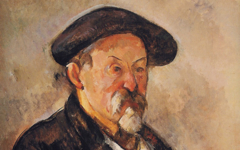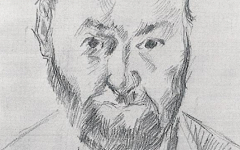Cézanne’s Large Bathers (c.1906)
Sidney Geist (1914-2005) was a sculptor and sometime-art historian who wrote a most unconventional book on Cezanne, published by Harvard University Press in 1988. It was slammed, spat on and torn to shreds by academics. John Rewald wrote that it “was a slap in the face of the scholarly community. It does not contain a single, solid new fact…...is filled with grotesque statements, cockeyed theories presented as scientific discoveries, interpretations based on the author’s wholly inadequate knowledge of the French language” and so on1. Yet, despite some wooly theories and strange claims, Geist still had certain insights so important and so game-changing for the interpretation of Cezanne’s art that they make Rewald’s contributions in that area seem pedantic and minor.
Take, for example, Cézanne’s vast canvas known as The Large Bathers in Philadelphia. Geist noticed what no-one had before that this idyllic scene of bathers was based on the head of a girl. Take a look at the next diagram and then switch back and forth between the two images until you see what Geist saw.
Click next thumbnail to continue
See (in the blue lines) how the trees are her tresses, two clouds suggest her eyes, her nose is where the sand-colored ground meets some trees, her mouth is a swimmer in the lake, her chin the shore. Geist considered the girl’s amorphous presence unintentional while still thinking the painting an homage to Cézanne’s wife.2
See conclusion below
This huge painting is nearly as important to Cézanne’s oeuvre as The Last Judgment is to Michelangelo’s. It is therefore certain that Cézanne, unlike historians today, was well aware of how Michelangelo had based The Last Judgement on Dante’s hidden profile in the Sistine Chapel. They are too alike to be coincidence. Indeed if Geist had been aware of Michelangelo's visual illusion, he might not have been so quick to think Cézanne's girl a subconscious feature. This was not even the first time that Cézanne placed heads like this in his compositions, as you can see in other entries here. Geist revealed some in his book; we found others.
What this painting actually means is difficult to determine with any precision. I like to think that it may depict a half-developed idea in Cézanne's mind. The poet Stephen Spender has described what it is like to be in that situation: "At this stage, a poem is like a face which one seems to be able to visualize clearly in the eye of memory, but when one examines it mentally or tries to think it out, feature by feature, it seems to fade."3
Sadly, Geist died before he could see anyone praise his insights in print but, sensing a kindred spirit, I visited him a few years before he died. I wanted to discuss my not-dissimilar ideas about Manet’s art and Le Dejeuner sur l’Herbe. He read my paper carefully, very carefully. He put notes where he thought I should add punctuation marks, he corrected typos and even suggested changes in grammar. He then trashed every idea in the paper. Most of what I wrote, he thought, was complete nonsense.
More Works by Cezanne
Notes:
1. “Cryptomorphs and Rebuses: A Double Disaster Befalls Cézanne”, Gazette des Beaux-Arts 108, May-June 1989, pp. 249-56
2. Geist, Interpreting Cezanne (Harvard University Press) 1988, pp. 1, 217
3. Stephen Spender, "The Making of a Poem" in The Creative Process, ed. Brewster Ghiselin (Mentor Books) 1952, p. 116
Original Publication Date on EPPH: 28 Sep 2010. | Updated: 0. © Simon Abrahams. Articles on this site are the copyright of Simon Abrahams. To use copyrighted material in print or other media for purposes beyond 'fair use', you must obtain permission from the copyright owner. Websites may link to this page without permission (please do) but may not reproduce the material on their own site without crediting Simon Abrahams and EPPH.





